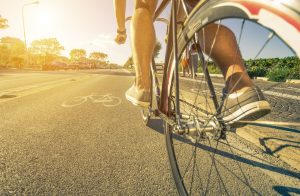Posted on August 31, 2017 by Kate Halsall
Some of you will know, a couple of weeks ago I took part in my first cycling Sportive. Prior to this I have taught endless hours of spin and commuted to work and back on my bike. But the transition from spin to actual cycling has been much HARDER than I thought! Trust me, cycling 20 miles on a spin bike is NOT the same as cycling 20 miles outside! Everyone I speak to says it’s the other way round – spin is way harder than cycling, but honestly I was a bit annoyed with how hard I found actual cycling! So why is this? I don’t know, but if I look at spinning vs cycling, that may give me a clue!
The caveat here of course is that I can’t really call myself a cyclist – yet! It’s only recently that I’ve started to get the miles in, and generally speaking I only do a max of 12-15 miles a day – if that! So what is listed below is a combination of my experience from teaching and taking part in spin classes, what other cyclists have told me and what I have read on the internet (which must be true!).
Muscles Used
Do you remember having stabilisers on your bike when you were a kid? Most of us do. And most of us remember that terrible moment when the stabilisers were removed and we were supposed to balance on 2 wheels without falling off. Well the transition between a spin bike to an outdoor bike is very similar! A spin bike is locked in the vertical plane/ horizontal position, but when you’re out on the road, the bike moves from side to side: it requires more muscle recruitment for balance and coordination.
Similarly, whilst spinning utilises the same muscles as cycling i.e. glutes, quads, hamstrings, calves and shins; that flywheel on the front of the spin bike helps to increase the number of pedal strokes you do each minute which apparently works the hamstrings harder. Alternatively, the friction of the road and wind resistance outdoors places more emphasis on the thighs and hip flexors (1)
Resistance
That same flywheel can mean that you let the spin bike do the work for you – as an instructor I call this freewheeling or cruising (you’re peddling very fast with no resistance). You control your resistance with a dial or a gear lever so you can make your workout on a spin bike really tough. I also stand and “climb” a lot on a spin bike with my classes – something I find near impossible for anything over 10 seconds on a outdoor bike. To be fair however, when you’re outdoors you also control your resistance with gears and with your choice of cycling routes. But try sitting in the saddle for the entire 45min when completing ascent after ascent – it’s a very different feeling!
Calories Burned
When I used to wear my fitbit to spin classes, I could burn anywhere between 350-500 calories in a 45 minute class. Compare this to the stats which suggest 100 calories an hour for a leisurely outdoors bike ride – you can understand why spin may appeal to some people. Just remember you can also really push yourself outdoors and this will increase your calorie burn.
So What’s The Conclusion?
There is no form of cycling which is best! Spin is a great way to build strength and fitness – I certainly wouldn’t have been able to 60 miles without suffering from DOMS without having done as much spin as I’ve done. However I suspect that the difference in muscle recruitment and emphasis on different muscle groups, combined with being in the saddle for a much greater amount of time is what made this transition to outdoor cycling much harder than I expected!
(1) https://www.theguardian.com/lifeandstyle/2008/may/10/healthandwellbeing.features2
https://wwws.fitnessrepublic.com/action/cycling/indoor-vs-outdoor-cycling-which-one-is-better.html
https://greatist.com/fitness/riding-spin-bike-or-riding-bike-outdoors
http://www.foxnews.com/lifestyle/2012/08/28/better-workout-indoor-cycling-vs-outdoor-cycling.html


